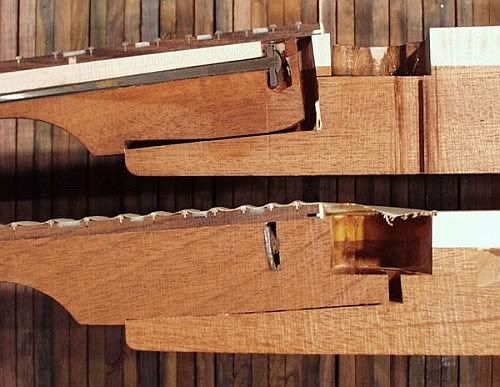JVsearch said:So what else can be done with all the heavy bits? Well, my opinion is that they should be used to make furniture or other wood things, and all the light tone wood should be reserved for guitars!
Cheers to that! Or use them in piano's, they're already heavy, what's a few more pounds? "Pardon me, I'm off to play the grand piano." :wink:
Here's an article if anyone's interested, I hope he uses the heavy bits for the bar...
http://www.woodweb.com/knowledge_base/African_Versus_Honduras_Mahogany.html
African Versus Honduras Mahogany
Woodworkers compare the grain characteristics, color, and machinability of different Mahogany varieties. November 19, 2005
Question
I am going to build a bar using either Honduras or African mahogany. My supplier has told me I can save significant money by using the African variety. Does anyone have any experience with the African variety? I know over time Honduras ages to a much deeper color than when it starts out. Is this the case with the African also? Any help with this would be appreciated.
Forum Responses
(Architectural Woodworking Forum)
From contributor A:
We have used 1000's of bd/ft of African for exterior millwork in the past 5 years. The most obvious issue with African is "ribbon striping". This is when the grain switches back and forth every four inches or so. It looks very attractive as veneer on furniture, but it is a real pain to mill (tearout). I've had my distributor sort out the ribbon stripe. Color wise it?s usually a pinkish/purple. I would recommend using a dark stain.
--------------------------------------------------------------------------------
From contributor R:
I?ve used African before, and the main problem I had was checking that only showed up after the finish was applied.
--------------------------------------------------------------------------------
From contributor G:
I've used a great deal of African, and am fairly happy with it. Contributor A and Contributor R mentioned a few of the problems. It can get "stringy" when machined. I also have seen stress cracks that run perpendicular to the grain.
--------------------------------------------------------------------------------
We use a great deal of quartered, because it has the ribbon striping on the face. I personally think the grain looks much nicer in "ribbon". But, Honduras can have that look too. I just don't see it as prevalent. I wouldn't hesitate using it again.
--------------------------------------------------------------------------------
From contributor W:
Stringy - you got that right. I was recently dadoing 3" wide African mahogany on my router table. Once I was finished, the bottom of the dados were so stringy and rough that it took over two hours to get them sanded smooth and not to mention all the fuzz and stringy material in the router collet and bit. It seems to me that that species always seems to have high moisture content and it seems to bow quite a bit after being ripped to size. It?s always a gamble. I don?t really like it but it does finish quite nicely.
--------------------------------------------------------------------------------
From contributor J:
I have inspected, bought, sold and machined both species for over thirty years. The guys that said it is "stringy, tears easy, etc...." are somewhat correct. Actually if all of your knives are sharp and your machinery is well maintained, you will not have those problems. African gets somewhat darker, but takes 15-20 years before you notice it. Also, to anyone who gets his/her distributor to lay out the "ribbon stripe", your distributor gladly does that. It brings a premium of anywhere from $600-$800 more. Almost all "true mahogany" moulding is African, but the laymen/general public has no idea.
--------------------------------------------------------------------------------
From contributor P:
Availability is the biggest issue here, along with price. I've had poor luck with the lighter colored mahoganies and I?ve had them fuzz from machining. Neither is very stable - rip a board on your table saw and watch it snake every which way. Spanish cedar is a pretty good cost effective option.
Comment from contributor M:
I have used a lot of both species. The African does not hold its color very well. When it?s exposed to light it will fade a lot more than the Honduras. The Honduras is heavier and finishes better, and probably is more stable. I do not want to use the African because it will not match the existing Honduras.






